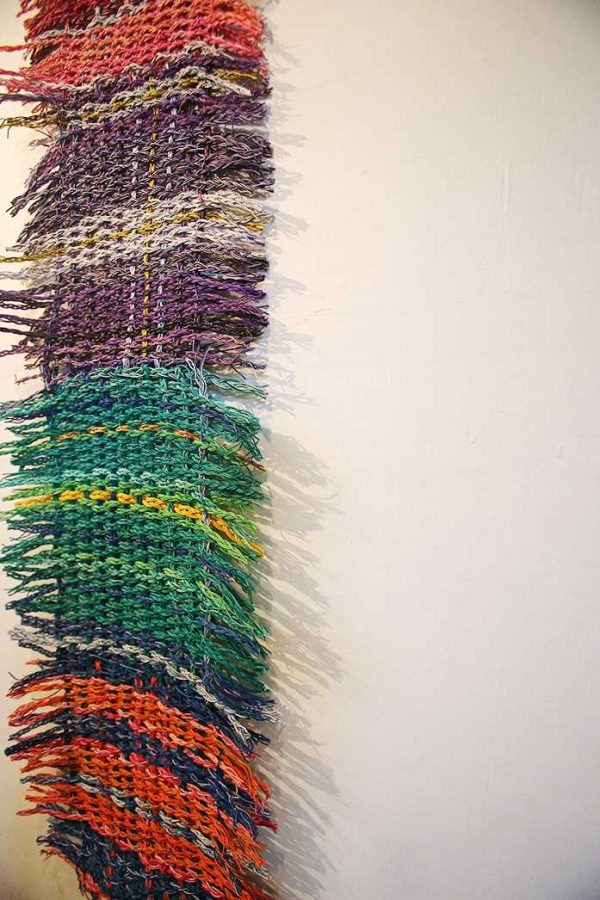The ax descends, widening a wound in the thick tree trunk. Wood chips splinter from its side, scattering. After hours of exertion, the logger has reduced the giant log to a frayed stump.
Then the labor begins again, a looping video showcased in Public Space One’s group exhibition, Maintenance Mode: A show of necessary work, open for its final days Friday and Saturday.
Not standard paintings, the pieces are a mix of video, performance art, and even botany installation. As with the whittled tree trunk, menial labor is the cornerstone of each piece. That relationship, artistic expression and necessary work, was vital in the exhibition’s inception.
“We all have to work, and as an artist it is frustrating to not have the time and energy you need to make art if you are also working a full-time job,” said Beatrice Drysdale, a key organizer. “I was wondering how the realities of the economic system that we live in as artists affect the art that we make.”
Does the impact always have to be negative? Will art always suffer for required labor, or can creative expression still prevail?
“Anything can be artful if you put intention into it,” said Kasey Bullerman, contributing artist and Public Space One gallery team member. “For example, doing laundry is tactile, visual, and physical; when you engage in it all at once, laundry becomes artful.”
Maintenance Mode’s forerunner, Manifesto For Maintenance Art 1969, introduced that perspective. Written by New York City artist Mierle Laderman Ukeles, her provocative declaration reclaimed domestic chores as art. Her broom became a paintbrush; her meatloaf was a sculpture.
“The Manifesto for Maintenance Art rejects this dichotomy and posits that these maintenance activities can be an artistic endeavor,” said Public Space One gallery team member and contributing artist Matthew Fleming.
It is a legacy that inspires long after publication.
“I wanted some of the pieces in the show to be about maintenance-type work,” Drysdale said. “I wanted, like Mierle, to put some of this kind of work — that is often hidden and in the background — into the foreground and highlight it a little bit.”
The exhibition does more than highlight maintenance work, it bridges art and “necessary work,” the subtitle of the exhibition.
“We bring art and practice into our daily lives out of necessity,” Bullerman said. “Necessity to transform inspiration and necessity to pay the bills and how they can overlap.”
The media chosen by locally, nationally, and internationally based artists complement and contrast while always circling Mode’s themes — art and labor, the latter concept more relatable to patrons.
The audience members may see themselves in M. Earl William’s video “Five Drives to Work.” The artist taped his drive to work on five different days. Shot out of the front windshield of his car, he layered the videos over one another to create a composite image. The viewer will watch each separate day meld into one until they are nearly indistinguishable.
Is it a testament to the monotony of 9-to-5 jobs or proof that creativity can have a presence in the mundane? Iowa City has had weeks to ponder the meaning, the gallery’s final showing 1-3 p.m. Saturday after opening Dec. 11, 2015. Few pieces in the exhibition lend a straightforward commentary on maintenance; in the gallery, wheatgrass grown hydroponically, undulating in water, fed by mineral nutrient solutions.
Patrons are invited to enter their email addresses into German artist Gretta Louw’s web-based work. With one click, their inboxes will receive a piece of her digital history, another file demanding digital maintenance.
“I think this piece speaks to a new kind of maintenance activity that we are tasked with now, and that is taking care of our digital files, organizing our digital lives,” Drysdale said.
Maintenance is integral in every aspect of the exhibition, down to the title plaques adorning each piece.
“We listed all the artists’ job titles on the labels by their work,” Drysdale said. “It illustrates how artists keep body and soul together while making their art. It shows again that not everyone makes a living from their art, but it also shows how important the art-making activity is, not just to artists but to audiences as well.”
GALLERY
Maintenance Mode: A show of necessary work
When: 1-3 p.m. Friday and Saturday
Where: Public Space One, 120 N. Dubuque



